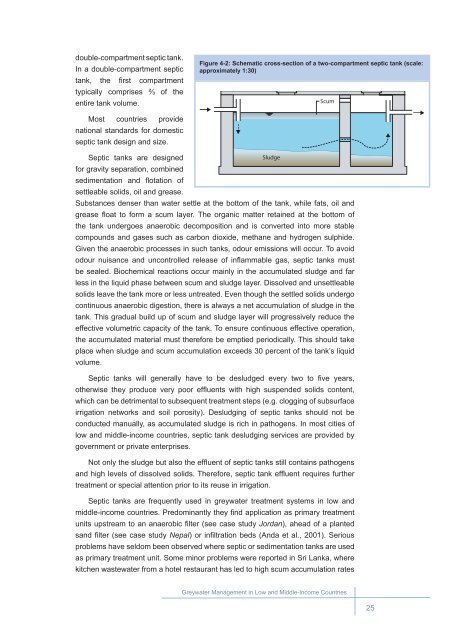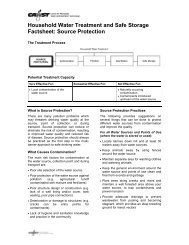Greywater Management in Low and Middle-Income Countries - SSWM
Greywater Management in Low and Middle-Income Countries - SSWM
Greywater Management in Low and Middle-Income Countries - SSWM
Create successful ePaper yourself
Turn your PDF publications into a flip-book with our unique Google optimized e-Paper software.
double-compartment septic tank.<br />
In a double-compartment septic<br />
<br />
<br />
entire tank volume.<br />
<br />
<br />
Scum<br />
Most countries provide<br />
national st<strong>and</strong>ards for domestic<br />
septic tank design <strong>and</strong> size.<br />
Septic tanks are designed<br />
for gravity separation, comb<strong>in</strong>ed<br />
<br />
settleable solids, oil <strong>and</strong> grease.<br />
Sludge<br />
Substances denser than water settle at the bottom of the tank, while fats, oil <strong>and</strong><br />
<br />
the tank undergoes anaerobic decomposition <strong>and</strong> is converted <strong>in</strong>to more stable<br />
compounds <strong>and</strong> gases such as carbon dioxide, methane <strong>and</strong> hydrogen sulphide.<br />
Given the anaerobic processes <strong>in</strong> such tanks, odour emissions will occur. To avoid<br />
<br />
be sealed. Biochemical reactions occur ma<strong>in</strong>ly <strong>in</strong> the accumulated sludge <strong>and</strong> far<br />
less <strong>in</strong> the liquid phase between scum <strong>and</strong> sludge layer. Dissolved <strong>and</strong> unsettleable<br />
solids leave the tank more or less untreated. Even though the settled solids undergo<br />
cont<strong>in</strong>uous anaerobic digestion, there is always a net accumulation of sludge <strong>in</strong> the<br />
tank. This gradual build up of scum <strong>and</strong> sludge layer will progressively reduce the<br />
effective volumetric capacity of the tank. To ensure cont<strong>in</strong>uous effective operation,<br />
the accumulated material must therefore be emptied periodically. This should take<br />
place when sludge <strong>and</strong> scum accumulation exceeds 30 percent of the tank’s liquid<br />
volume.<br />
<br />
<br />
which can be detrimental to subsequent treatment steps (e.g. clogg<strong>in</strong>g of subsurface<br />
irrigation networks <strong>and</strong> soil porosity). Desludg<strong>in</strong>g of septic tanks should not be<br />
conducted manually, as accumulated sludge is rich <strong>in</strong> pathogens. In most cities of<br />
low <strong>and</strong> middle-<strong>in</strong>come countries, septic tank desludg<strong>in</strong>g services are provided by<br />
government or private enterprises.<br />
<br />
<br />
treatment or special attention prior to its reuse <strong>in</strong> irrigation.<br />
Septic tanks are frequently used <strong>in</strong> greywater treatment systems <strong>in</strong> low <strong>and</strong><br />
<br />
Jordan), ahead of a planted<br />
Nepal<br />
problems have seldom been observed where septic or sedimentation tanks are used<br />
as primary treatment unit. Some m<strong>in</strong>or problems were reported <strong>in</strong> Sri Lanka, where<br />
kitchen wastewater from a hotel restaurant has led to high scum accumulation rates<br />
<strong>Greywater</strong> <strong>Management</strong> <strong>in</strong> <strong>Low</strong> <strong>and</strong> <strong>Middle</strong>-<strong>Income</strong> <strong>Countries</strong><br />
25
















